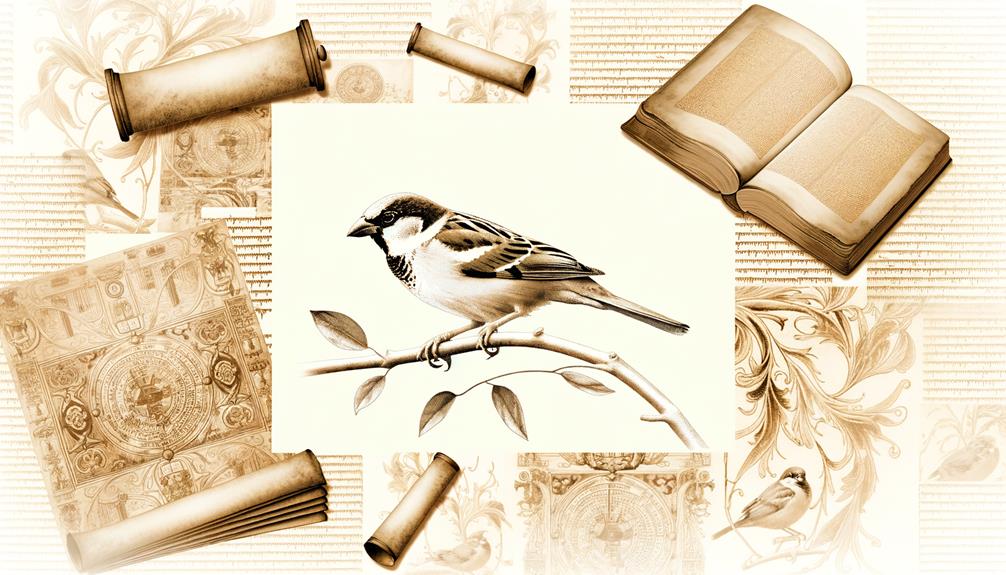Eye of the Sparrow: Cultural Meaning?
The phrase 'eye of the sparrow' embodies vigilant protection, divine oversight, and resilience. Ancient cultures like Greek, Roman, and Chinese associated sparrows with virtues such as industriousness and humility.
Biblically, sparrows symbolize divine care and unwavering faith. Literary works often highlight their themes of watchfulness and spiritual guardianship.
Musicians use the sparrow to signify comfort and guidance. Modern interpretations see sparrows as symbols of resilience and community.
Observing sparrows has psychological benefits, including reduced stress and enhanced mood. Exploring further reveals more profound insights into its enduring significance across multiple dimensions.

Key Takeaways
- The 'eye of the sparrow' symbolizes divine care, protection, and unwavering faith from biblical references.
- It represents vigilance, acute perception, and spiritual guardianship in various literary works.
- In music, the phrase signifies divine oversight, comfort, and guidance, reflecting spiritual insight.
- Sparrows symbolize resilience, adaptability, community, and persistence in modern interpretations and personal expressions.
- Observing sparrows promotes tranquility, reduces stress, and enhances mental well-being through their consistent, calming movements.
Historical Origins

The phrase 'Eye of the Sparrow' has its historical origins deeply rooted in various religious texts and cultural folklore, illustrating the symbolic significance of the sparrow across different societies.
In ancient Greek and Roman cultures, sparrows were associated with the goddess Aphrodite (Venus), symbolizing love and fertility.
In Chinese tradition, they represented industriousness and cooperation. The sparrow's ability to thrive in diverse environments made it a symbol of resilience and adaptability.
Additionally, medieval European literature often depicted sparrows as symbols of lowly virtue and humility. Across these cultures, the sparrow's keen observation, represented by its 'eye,' connoted vigilance and attentiveness.
Therefore, the historical origins of the phrase reflect a tapestry of meanings attributed to this modest bird.
Biblical References
In examining the biblical references, the phrase 'eye of the sparrow' encapsulates God's providential care, symbolizing faith and divine assurance.
The sparrow's mention in scriptures, particularly in Matthew 10:29-31, illustrates God's meticulous attention to even the smallest of creatures.
This metaphor underscores the theological principle that God's care extends to all aspects of creation, offering believers a profound sense of security and trust.
God's Providential Care
Numerous biblical passages highlight God's providential care, emphasizing His meticulous attention to even the smallest aspects of creation.
Matthew 10:29-31 illustrates this by noting that not a single sparrow falls to the ground outside of God's will, underscoring His omnipresence and omnipotence.
Additionally, Psalm 147:4-5 reveals God's thorough knowledge and power by stating He counts the stars and calls them by name, further affirming His detailed oversight.
Such references collectively suggest a divine governance that extends to all entities, regardless of their perceived significance.
Symbol of Faith
Beyond illustrating God's meticulous care for His creation, the sparrow also serves as a potent symbol of faith in biblical literature. This symbolism is evidenced through several key references:
- Matthew 10:29-31 – Jesus reassures His followers by noting that not even a sparrow falls to the ground outside the Father's care.
- Luke 12:6-7 – Echoing Matthew, this passage emphasizes the value of each individual, comparing them to sparrows.
- Psalm 84:3 – Here, the sparrow finds a home near God's altar, symbolizing a deep spiritual connection.
- Psalm 102:7 – The psalmist's comparison to a lonely sparrow illustrates human vulnerability and reliance on divine faith.
These passages collectively underscore the sparrow's role as a symbol of unwavering faith and divine attention.
Divine Assurance
Biblical references to sparrows provide clear evidence of divine assurance, illustrating God's attentive care and protection over even the smallest aspects of His creation. In Matthew 10:29-31, Jesus notes that not a single sparrow falls to the ground outside the Father's will, emphasizing His sovereign control.
Additionally, in Luke 12:6-7, sparrows are highlighted again, underscoring their low monetary value yet significant worth in God's eyes. These passages collectively suggest a meticulous divine watchfulness, extending comfort to believers by affirming that they're valued far more than sparrows.
This theological perspective reinforces the notion that God's providence encompasses every detail of existence, ensuring that nothing, however trivial, escapes His notice or care.
Literary Appearances

In literary texts, the phrase 'eye of the sparrow' often symbolizes vigilance and divine oversight, appearing in works ranging from classical poetry to contemporary fiction. Analyzing its occurrences reveals the depth of its metaphorical significance.
- Classical Poetry: Ancient poets used the sparrow's eye to denote watchfulness, suggesting a higher power's constant vigilance.
- Religious Literature: The phrase appears in religious texts, reinforcing themes of divine care and protection.
- Modern Novels: Contemporary authors employ the sparrow motif to explore themes of human frailty and spiritual guardianship.
- Children's Stories: In juvenile literature, the sparrow's eye often represents innocence under benevolent watch.
This multifaceted symbol provides rich layers of meaning, contributing to the narrative complexity and thematic depth across various literary genres.
Musical Interpretations
Shifting from literary to musical domains, the phrase 'eye of the sparrow' finds its resonance in various genres, where musicians often use it to evoke themes of vigilance, protection, and spiritual insight.
In gospel music, the phrase signifies divine oversight and comfort, as seen in the hymn 'His Eye Is on the Sparrow.' Contemporary artists incorporate this imagery to highlight resilience and awareness.
For instance, in folk and indie music, sparrows symbolize watchfulness and guidance, often reflecting a personal or existential journey. Analyzing these interpretations reveals a consistent use of the sparrow's eye as a metaphor for acute perception and safeguarding, bridging emotional and philosophical undertones across musical landscapes.
The phrase thereby serves as a powerful thematic device.
Cultural Symbolism

The sparrow holds significant spiritual symbolism across various cultures, often representing freedom, resilience, and communal harmony.
Historical instances reveal its depiction in ancient texts and art, symbolizing vigilance and protection.
These cultural representations underscore the sparrow's role in conveying profound philosophical and moral lessons globally.
Spiritual Significance Globally
Across various cultures, the eye of the sparrow symbolizes vigilance, protection, and a connection to the divine. This symbol's spiritual significance is multifaceted, reflecting a deep-seated reverence for the natural world.
Analytical examination reveals common themes:
- Vigilance: The sparrow's sharp eyesight is often connected to heightened awareness and the ability to foresee potential threats.
- Protection: Many cultures believe that the sparrow's watchfulness extends a protective aura over individuals and communities.
- Divine Connection: The sparrow is frequently seen as a messenger between the earthly and spiritual domains, embodying a conduit for divine communication.
- Resilience: Despite their small size, sparrows are resilient, symbolizing strength and perseverance in the face of adversity.
These elements underscore the sparrow's role in global spiritual symbolism.
Historical Symbolism Instances
In ancient Egyptian culture, the sparrow's eye symbolized vigilance and was often depicted in hieroglyphics as an emblem of protection and watchfulness. This avian symbol was thought to guard against evil spirits and provide spiritual oversight.
Similarly, in ancient Greece, sparrows were associated with Aphrodite, symbolizing love and fidelity. In Chinese folklore, sparrows represented industriousness and community, reflecting societal values of hard work and cooperation.
Native American tribes considered sparrows as messengers, linking the earthly and spiritual spheres. These diverse cultural contexts highlight the sparrow's adaptability in symbolic representation, underscoring its universal appeal as a signifier of important values such as protection, love, industriousness, and spiritual communication.
Each instance underscores the sparrow's enduring significance across civilizations.
Spiritual Significance
Within various spiritual traditions, the sparrow often symbolizes vigilance, joy, and simplicity, indicating its profound role in human spirituality. This small bird's presence is frequently associated with deeper spiritual meanings across cultures, reflecting significant human values.
- Vigilance: Sparrows are always alert and aware of their surroundings, symbolizing mindfulness and attention in spiritual practices.
- Joy: Their cheerful songs and social behavior represent happiness and a positive outlook.
- Simplicity: Sparrows thrive in modest environments, teaching the importance of living simply and appreciating the small things.
- Freedom: Their ability to fly freely signifies the soul's liberation and spiritual ascension.
Modern Usage

The sparrow's symbolism has evolved in modern contexts to encompass themes of resilience, adaptability, and community in various cultural narratives and personal interpretations.
In literature and media, sparrows often represent the strength found in small, overlooked entities. Their adaptability in urban environments exemplifies survival against odds, making them symbols of persistence.
Community-driven aspects of sparrow behavior, such as flocking, underscore themes of unity and mutual support. In personal interpretations, sparrows are frequently seen as emblems of hope and perseverance.
Their prevalence in tattoos and popular art further reinforces these themes, highlighting their enduring significance. Consequently, the sparrow's modern symbolism is multifaceted, reflecting contemporary values and aspirations through a blend of resilience, adaptability, and communal harmony.
Psychological Impact
Numerous studies suggest that observing sparrows can greatly enhance mental well-being by promoting feelings of calmness and connection to nature. The psychological benefits are both profound and measurable:
- Stress Reduction: Watching sparrows can lower cortisol levels, reducing overall stress.
- Mood Enhancement: Interaction with these birds has been shown to elevate serotonin levels, improving mood.
- Cognitive Function: Sparrow observation can enhance focus and cognitive performance by providing a peaceful distraction.
- Social Connectivity: Birds foster a sense of community, encouraging social interaction and reducing feelings of loneliness.
These findings highlight the significant impact that even small, everyday encounters with nature can have on mental health. The presence of sparrows, as a result, serves as a simple yet effective tool for psychological well-being.
Personal Reflections

Many individuals report a profound sense of tranquility and introspection when observing sparrows in their natural habitats. This phenomenon can be attributed to the bird's unassuming presence and rhythmic behaviors.
When people watch sparrows, they often engage in reflective thinking, noting the bird's simplicity and resilience. Such observations can trigger a meditative state, promoting psychological well-being. Scientifically, these moments of quiet contemplation may reduce stress levels by lowering cortisol production.
Additionally, the sparrow's consistent and predictable movements can serve as a calming influence, providing a sense of stability in an otherwise chaotic world. These personal reflections underscore the therapeutic potential of engaging with nature, highlighting the profound impact even small creatures like sparrows can have on human mental health.
Conclusion
The phrase 'eye of the sparrow' captures a profound tapestry of historical, biblical, and cultural threads. It symbolizes watchfulness, divine care, and resilience. Through various mediums—literature, music, and daily vernacular—it reflects humanity's quest for meaning and connection.
This small bird's gaze, sharp and unwavering, serves as a metaphor for the human spirit's unyielding vigilance and hope. In modern usage, it continues to impact psychological well-being, embodying an enduring symbol of spiritual and emotional fortitude.






